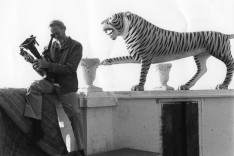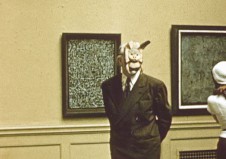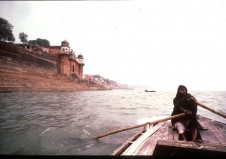Forest of Bliss: A Tribute to Robert Gardner

Robert Gardner filming Forest of Bliss
Join us as we pay tribute to the late filmmaker Robert Gardner, who died in 2014. Filmmaker Robert Fenz and anthropologist Nancy Lutkehaus share their thoughts on Gardner's complicated and vital legacy, and together we'll watch his early film, Mark Tobey, and his acknowledged masterpiece, Forest of Bliss.
“A friend and collaborator to countless artists, poets and philosophers, Gardner surrounded himself with inspiration and talent. He made several cinematic tributes to his artist friends like Mark Tobey, Sean Scully and the filmmaker Miklos Jansco. He also wrote and published accounts of his travels and films, worked on unfinished fictional film scripts and left behind a trail of aborted projects. Most profoundly, his influence reverberates throughout contemporary documentary work today, from the work of filmmakers like Sharon Lockhart and Lucien Castaing-Taylor to the current students of Harvard’s own Sensory Ethnography Lab who have fully adopted an experimental approach to the ethnographic. – Brittany Gravely
Robert Gardner and Peter Matthiessen in conversation, 1996
For more event information: www.lafilmforum.org, or 323-377-7238
Tickets: $10 general, $6 students/seniors; free for Filmforum members. Available by credit card in advance from Brown Paper Tickets at http://bpt.me/1148010 or at the door
Robert Gardner was an internationally renowned filmmaker and author whose works have entered the permanent canon of non-fiction filmmaking. Some of his most prominent films include Dead Birds (1963), a lyric account of the Dugum Dani, a Stone Age society at one time living an isolated existence in the Highlands of the former Netherlands New Guinea (Gardner was the leader of the Peabody Museum-sponsored expedition to study the Dani in 1961-62); Rivers of Sand (1974), a social commentary on the Hamar people of southwestern Ethiopia; and Forest of Bliss (1985), a cinematic essay on the ancient city of Benares, India, which explores the ceremonies, rituals, and industries associated with death and regeneration.
Gardner's films have received numerous awards, including the Robert J. Flaherty Award for best nonfiction film (twice); the Golden Lion for Best Film at the Florence Film Festival (three times); and First Prizes at the Trento, USA Dallas, Melbourne, Nuoro, EarthWatch, Athens, and San Francisco film festivals. His films have been invited to Festivals throughout the world including Jerusalem, Bergen, London, Munich, Toronto, Montreal, Margaret Mead, Marseilles, Locarno, Chicago and Cinema du Réel.
Robert Gardner is the author of A Human Document (1965); and Gardens of War (1968). His book, Making Forest of Bliss (2002), is the outcome of a close watching of the film with his collaborator, Ákos Östör. In 2006 Gardner published his book entitled The Impulse to Preserve: Reflections of a Filmmaker and his latest book, Making Dead Birds: Chronicle of a Film, was published November, 2007. He is also the subject of three books, Rituale von Leben und Tod: Robert Gardner und seine Filme (1989); Gardner, by Harry Tomicek (1991); and Natural Rhythms: The Indigenous World of Robert Gardner, by Thomas Cooper (1996).
In the 1970s Gardner produced and hosted Screening Room, a series of more than one hundred 90-minute programs on independent and experimental filmmaking. The series, considered an invaluable historical record of modern cinema, has been transferred to digital format, for archival preservation by the Museum of Film and Broadcasting in New York City. Gardner was the Director of the Film Study Center at Harvard University from 1957 to 1997. He passed away on June 21, 2014. Visit Robert Gardner's website: www.robertgardner.net
Nancy Lutkehaus is a Visual Anthropologist who done research in Papua New Guinea and other parts of the Pacific, including West Papua where Robert Gardner filmed Dead Birds. She is a former editor of "Visual Anthropology Review" and has taught workshops on ethnographic film with Timothy Ash and Jean Rouch. Her most recent book, Margaret Mead: The Making of an American Icon, looks at Mead's relationship with the media. She is currently working on a book about anthropology and art, with a focus on the display of non-western art in the Michael Rockefeller Wing of New York City's Metropolitan Museum of Art. She is the Co-Director of the Center for Visual Anthropology at the University of Southern California.
Robert Fenz is an artist working with analogue film and photography, currently based in Berlin and Los Angeles. His films were featured in the Whitney Biennials of 2002 and 2008 and have been the subject of solo screenings at New York's Museum of Modern Art; the Harvard Film Archive, Cambridge; the Cinémathèque Française, Paris; the Rotterdam and Locarno International Film Festivals; and worldwide at many other recognized venues. He was an associate of the Film Study Center at Harvard University from 2003-2004. While there he worked to preserve the films and field recording of Documentarian and author Robert Gardner. Fenz has been an associate of studio7arts since Gardner founded it 2005. (Studio7Arts produces, promotes and supports work that interprets the world through the creation of nonfiction media. Studio7Arts is a registered 501c-3 corporation.)
From 2007-2008 he retraced Gardner’s steps. Filming in locations important to Gardner’s body of work. Dead Birds (1964) was filmed in West Papua, Rivers of Sand (1974) was filmed in Ethiopia, and Forest of Bliss (1986) was filmed in Benares, India. Fenz’s 16mm tribute to Gardner, Correspondence was completed in 2011.

Mark Tobey
Mark Tobey
(1952, color, 19 minutes)
Mark Tobey was made while the painter lived in Seattle Washington early in the 1950s. It is the second film made by Robert Gardner and it shows in cinematic language how this man looked at the world. It is a document in which Tobey himself both performs and is observed. The style is related to certain experimental tendencies of the period especially those of Maya Deren.
A unique film in the Gardner ouvre, the film not only presents an experimental portrait of Tobey, but serves as a window into the American art, avant-garde film, and poetic movements of this period.

Forest of Bliss
Forest of Bliss
Directed by Robert Gardner, produced with Ákos Östör
1986, color, 90 min
Forest of Bliss is an unsparing yet redemptive account of the inevitable griefs, religious passions and frequent happinesses that punctuate daily life in Benares, India's most holy city. The film unfolds from one sunrise to the next without commentary, subtitles or dialogue. It is an attempt to give the viewer a wholly authentic, though greatly magnified and concentrated, sense of participation in the experiences examined by the film.
